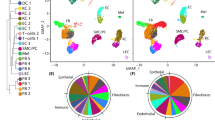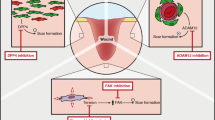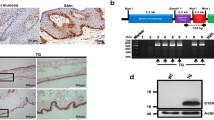Abstract
Differentiation of fibroblasts to myofibroblasts and collagen fibrillogenesis are two processes essential for normal cutaneous development and repair, but their misregulation also underlies skin-associated fibrosis. Periostin is a matricellular protein normally expressed in adult skin, but its role in skin organogenesis, incisional wound healing and skin pathology has yet to be investigated in any depth. Using C57/BL6 mouse skin as model, we first investigated periostin protein and mRNA spatiotemporal expression and distribution during development and after incisional wounding. Secondarily we assessed whether periostin is expressed in human skin pathologies, including keloid and hypertrophic scars, psoriasis and atopic dermatitis. During development, periostin is expressed in the dermis, basement membrane and hair follicles from embryonic through neonatal stages and in the dermis and hair follicle only in adult. In situ hybridization demonstrated that dermal fibroblasts and basal keratinocytes express periostin mRNA. After incisional wounding, periostin becomes re-expressed in the basement membrane within the dermal-epidermal junction at the wound edge re-establishing the embryonic deposition pattern present in the adult. Analysis of periostin expression in human pathologies demonstrated that it is over-expressed in keloid and hypertrophic scars, atopic dermatitis, but is largely absent from sites of inflammation and inflammatory conditions such as psoriasis. Furthermore, in vitro we demonstrated that periostin is a transforming growth factor beta 1 inducible gene in human dermal fibroblasts. We conclude that periostin is an important ECM component during development, in wound healing and is strongly associated with pathological skin remodeling.
Summary: Periostin is a fibrogenic protein that mediates fibroblast differentiation and extracellular matrix synthesis. Here, we show that periostin is dynamically and temporally expressed during skin development, is induced by TGF-β1 in vitro and is significantly upregulated during wound repair as well as cutaneous pathologies.






Similar content being viewed by others
Abbreviations
- BM:
-
Basement membrane
- DEJ:
-
Dermal-epidermal junction
- E:
-
Embryonic
- ECM:
-
Extracellular matrix
- HF:
-
Hair follicle
- ISH:
-
In situ hybridization
- P:
-
Postnatal
- SB:
-
Subcutaneous tissue
- TGF-β:
-
Transforming growth factor beta
References
Berk BC, Fujiwara K, Lehoux S (2007) ECM remodeling in hypertensive heart disease. J Clin Invest 117(3):568–575
Bornstein P, Sage EH (2002) Matricellular proteins: extracellular modulators of cell function. Curr Opin Cell Biol 14:608–616
Boulais N, Misery L (2008) The epidermis: a sensory tissue. Eur J Dermatol 18:119–127
Butcher JT, Norris RA, Hoffman S, Mjaatvedt CH, Markwald RR (2007) Periostin promotes atrioventricular mesenchyme matrix invasion and remodeling mediated by integrin signaling through Rho/PI 3-kinase. Dev Biol 302:256–266
Chen YF, Feng JA, Li P, Xing D, Ambalavanan N, Oparil S (2006) Atrial natriuretic peptide-dependent modulation of hypoxia-induced pulmonary vascular remodeling. Life Sci 79:1357–1365
Chen Y, Leask A, Abraham DJ, Pala D, Shiwen X, Khan K, Liu S, Carter DE, Wilcox-Adelman S, Goetinck P et al (2008) Heparan sulfate-dependent ERK activation contributes to the overexpression of fibrotic proteins and enhanced contraction by scleroderma fibroblasts. Arthritis Rheum 58:577–585
Conway SJ, Molkentin JD (2008) Periostin as a heterofunctional regulator of cardiac development and disease. Curr Genomics 9:548–555
Darby IA, Hewitson TD (2007) Fibroblast differentiation in wound healing and fibrosis. Int Rev Cytol 257:143–179
Gillan L, Matei D, Fishman DA, Gerbin CS, Karlan BY, Chang DD (2002) Periostin secreted by epithelial ovarian carcinoma is a ligand for alpha(V)beta(3) and alpha(V)beta(5) integrins and promotes cell motility. Cancer Res 62:5358–5364
Hamilton DW (2008) Functional role of periostin in development and wound repair: implications for connective tissue disease. J Cell Commun Signal 2:9–17
Hamilton DW, Chehroudi B, Brunette DM (2007) Comparative response of epithelial cells and osteoblasts to microfabricated tapered pit topographies in vitro and in vivo. Biomaterials 28:2281–2293
Horiuchi K, Amizuka N, Takeshita S, Takamatsu H, Katsuura M, Ozawa H, Toyama Y, Bonewald LF, Kudo A (1999) Identification and characterization of a novel protein, periostin, with restricted expression to periosteum and periodontal ligament and increased expression by transforming growth factor beta. J Bone Miner Res 14:1239–1249
Jackson-Boeters L, Wen W, Hamilton DW (2009) Periostin localizes to cells in normal skin, but is associated with the extracellular matrix during wound repair. J Cell Commun Signal 3:125–133
Kanno A, Satoh K, Masamune A, Hirota M, Kimura K, Umino J, Hamada S, Satoh A, Egawa S, Motoi F et al (2008) Periostin, secreted from stromal cells, has biphasic effect on cell migration and correlates with the epithelial to mesenchymal transition of human pancreatic cancer cells. Int J Cancer 122:2707–2718
Kokubu E, Hamilton DW, Inoue T, Brunette DM (2009) Modulation of human gingival fibroblast adhesion, morphology, tyrosine phosphorylation, and ERK 1/2 localization on polished, grooved and SLA substratum topographies. J Biomed Mater Res A 91:663–670
Kruzynska-Frejtag A, Wang J, Maeda M, Rogers R, Krug E, Hoffman S, Markwald RR, Conway SJ (2004) Periostin is expressed within the developing teeth at the sites of epithelial-mesenchymal interaction. Dev Dyn 229(4):857–868
Kuhn B, del Monte F, Hajjar RJ, Chang YS, Lebeche D, Arab S, Keating MT (2007) Periostin induces proliferation of differentiated cardiomyocytes and promotes cardiac repair. Nat Med 13:962–969
Li J, Chen J, Kirsner R (2007) Pathophysiology of acute wound healing. Clin Dermatol 25:9–18
Li G, Jin R, Norris RA, Zhang L, Yu S, Wu F, Markwald RR, Nanda A, Conway SJ, Smyth SS et al (2009) Periostin mediates vascular smooth muscle cell migration through the integrins alphanubeta3 and alphanubeta5 and focal adhesion kinase (FAK) pathway. Atherosclerosis
Lie-Venema H, Eralp I, Markwald RR, van den Akker NM, Wijffels MC, Kolditz DP, van der Laarse A, Schalij MJ, Poelmann RE, Bogers AJ et al (2008) Periostin expression by epicardium-derived cells is involved in the development of the atrioventricular valves and fibrous heart skeleton. Differentiation
Lindner V, Wang Q, Conley BA, Friesel RE, Vary CP (2005) Vascular injury induces expression of periostin: implications for vascular cell differentiation and migration. Arterioscler Thromb Vasc Biol 25:77–83
Lindsley A, Snider P, Zhou H, Rogers R, Wang J, Olaopa M, Kruzynska-Frejtag A, Koushik SV, Lilly B, Burch JB, Firulli AB, Conway SJ (2007) Identification and characterization of a novel Schwann and outflow tract endocardial cushion lineage-restricted periostin enhancer. Dev Biol 307(2):340–355
Liu S, Kapoor M, Shi-wen X, Kennedy L, Denton CP, Glogauer M, Abraham DJ, Leask A (2008) Role of Rac1 in a bleomycin-induced scleroderma model using fibroblast-specific Rac1-knockout mice. Arthritis Rheum 58:2189–2195
Loewenthal LJ (1963) Anatomy and histochemistry of Skin L961. Dermatologica 126:380–387
Loewenthal LJ (1964) Anatomy and histochemistry of Skin 1962. Dermatologica 129:507–515
Midwood KS, Williams LV, Schwarzbauer JE (2004) Tissue repair and the dynamics of the extracellular matrix. Int J Biochem Cell Biol 36(6):1031–1037
Nomura I, Gao B, Boguniewicz M, Darst MA, Travers JB, Leung DY (2003) Distinct patterns of gene expression in the skin lesions of atopic dermatitis and psoriasis: a gene microarray analysis. J Allergy Clin Immunol 112:1195–1202
Norris RA, Damon B, Mironov V, Kasyanov V, Ramamurthi A, Moreno-Rodriguez R, Trusk T, Potts JD, Goodwin RL, Davis J et al (2007) Periostin regulates collagen fibrillogenesis and the biomechanical properties of connective tissues. J Cell Biochem 101:695–711
Norris RA, Borg TK, Butcher JT, Baudino TA, Banerjee I, Markwald RR (2008a) Neonatal and adult cardiovascular pathophysiological remodeling and repair: developmental role of periostin. Ann N Y Acad Sci 1123:30–40
Norris RA, Moreno-Rodriguez RA, Sugi Y, Hoffman S, Amos J, Hart MM, Potts JD, Goodwin RL, Markwald RR (2008b) Periostin regulates atrioventricular valve maturation. Dev Biol 316:200–213
Norris RA, Potts JD, Yost MJ, Junor L, Brooks T, Tan H, Hoffman S, Hart MM, Kern MJ, Damon B et al (2009) Periostin promotes a fibroblastic lineage pathway in atrioventricular valve progenitor cells. Dev Dyn
Rios HF, Ma D, Xie Y, Giannobile WV, Bonewald LF, Conway SJ, Feng JQ (2008) Periostin is essential for the integrity and function of the periodontal ligament during occlusal loading in mice. J Periodontol 79:1480–1490
Ruan K, Bao S, Ouyang G (2009) The multifaceted role of periostin in tumorigenesis. Cell Mol Life Sci
Shibusawa Y, Negishi I, Tabata Y, Ishikawa O (2008) Mouse model of dermal fibrosis induced by one-time injection of bleomycin-poly(L-lactic acid) microspheres. Rheumatology (Oxford) 47:454–457
Shimazaki M, Nakamura K, Kii I, Kashima T, Amizuka N, Li M, Saito M, Fukuda K, Nishiyama T, Kitajima S et al (2008) Periostin is essential for cardiac healing after acute myocardial infarction. J Exp Med
Snider P, Hinton RB, Moreno-Rodriguez RA, Wang J, Rogers R, Lindsley A, Li F, Ingram DA, Menick D, Field L et al (2008) Periostin is required for maturation and extracellular matrix stabilization of noncardiomyocyte lineages of the heart. Circ Res 102:752–760
Sumiyoshi K, Nakao A, Ushio H, Mitsuishi K, Okumura K, Tsuboi R, Ra C, Ogawa H (2002) Transforming growth factor-beta1 suppresses atopic dermatitis-like skin lesions in NC/Nga mice. Clin Exp Allergy 32:309–314
Takayama G, Arima K, Kanaji T, Toda S, Tanaka H, Shoji S, McKenzie AN, Nagai H, Hotokebuchi T, Izuhara K (2006) Periostin: a novel component of subepithelial fibrosis of bronchial asthma downstream of IL-4 and IL-13 signals. J Allergy Clin Immunol 118:98–104
Takeshita S, Kikuno R, Tezuka K, Amann E (1993) Osteoblast-specific factor 2: cloning of a putative bone adhesion protein with homology with the insect protein fasciclin I. Biochem J 294(Pt 1):271–278
Yan W, Shao R (2006) Transduction of a mesenchyme-specific gene periostin into 293T cells induces cell invasive activity through epithelial-mesenchymal transformation. J Biol Chem 281:19700–19708
Acknowledgments
We thank Prof. Jeffery B. Travers (Departments of Dermatology and Pediatrics, IUPUI) for providing the fixed skin biopsy specimens and Linda Jackson-Boeters (Department of Pathology, UWO) for advice on histological analysis. This work was supported, in part, by the National Institutes of Health (S.J.C), the IU Department of Pediatrics (Cardiology) and Riley Children’s Foundation (H-M.Z), Natural Sciences and Engineering Research Council (C.E) and the Canadian Institutes of Health Research IMHA operating grants (D.W.H).
Conflict of interest
None
Author information
Authors and Affiliations
Corresponding authors
Rights and permissions
About this article
Cite this article
Zhou, HM., Wang, J., Elliott, C. et al. Spatiotemporal expression of periostin during skin development and incisional wound healing: lessons for human fibrotic scar formation. J. Cell Commun. Signal. 4, 99–107 (2010). https://doi.org/10.1007/s12079-010-0090-2
Received:
Accepted:
Published:
Issue Date:
DOI: https://doi.org/10.1007/s12079-010-0090-2




